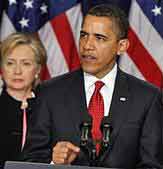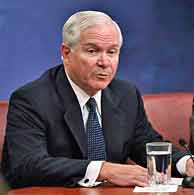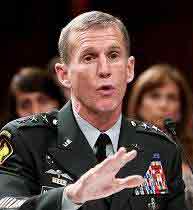Get Flash Player
Download
The publication Monday of a secret assessment by the new U.S. and NATO commander in Afghanistan has sparked a fresh round of debate about what the coalition strategy should be and how many troops are needed to implement it.

President Barack Obama laid out his strategy for Afghanistan in March. He said the main goal must be to prevent the country from again becoming a base for terrorist attacks on the United States as it was in 2001, which he said requires preventing the Taliban from returning to power. And he added this:
"For six years Afghanistan has been denied the resources that it demands because of the war in Iraq. Now we must make a commitment that can accomplish our goals," he said.
Now, the president's new commander in Afghanistan has presented his resource requirements. In a secret assessment published by The Washington Post Monday, General Stanley McChrystal says he needs more forces and, without them, the effort faces possible failure. The general has not made a specific troop request, but experts say he could ask for as many as 40,000, maybe more, on top of the doubling of U.S. troop strength to 68,000 in the past year.
After seeing the general's grim assessment, President Obama told American television networks over the weekend he is in the process of reviewing his own six-month-old strategy, and he questioned whether supporting the Afghan government, building its security forces and securing key provinces, is the right approach. All that is in General McChrystal's plan.

Last week, Defense Secretary Robert Gates appealed for patience as the administration works through the issue.
"Frankly I believe that the president deserves the right to absorb the assessment himself and have his questions and my questions and others' questions relating to the assessment answered," Gates said.
In addition, officials now say General McChrystal's assessment is just one part of a broader Afghanistan strategy review by the administration, its second since the president took office in January.
The president's apparent hesitation to approve the military plan to implement the strategy he announced in March leaves many analysts confused. In editorials, The Washington Post called the review "startling," and the USA Today newspaper said there is "a yawning need for clarity" and warned against trying to use half-measures to achieve important goals.
Analyst Thomas Donnelly at the conservative American Enterprise Institute says President Obama should accept the McChrystal recommendations, and then convince the American public to go along. Public opinion polls indicate growing skepticism among Americans.

"Well they certainly will be doubtful of it unless President Obama makes a strong argument. A year ago, he was campaigning for the presidency on the presumption that Iraq was a big mistake and we needed to focus on Afghanistan. No wonder that with an uncertain voice coming out of the White House, Americans will have their doubts," Donnelly said.
On the other side of the political spectrum, Jonathan Morganstein of the progressive Third Way research organization, also endorses the McChrystal assessment, and says the president should accept the general's recommendations.
"I don't think anything there was a surprise. What the assessment says is, basically, things are catastrophically bad in Afghanistan, which is, I'd say, objectively true, but that things are not unsalvageable, that we can turn this around as long as we stay dedicated to the appropriate strategy and fully resource that strategy. Everything that General McChrystal has laid out makes sense to me," Morganstein said.
Morganstein, who is also an officer in the Marine Corps Reserves, says U.S. troops are now experienced at fighting insurgents, on the battlefield and in the society. He says American forces will be able to defeat the Taliban and al-Qaida in Afghanistan - as they made significant gains against insurgents in Iraq - if the president sends enough troops and other resources to do the job.
But for Mr. Obama, the decision is not that easy. Just a few months ago, he approved the latest increase of more than 20,000 U.S. troops in Afghanistan, allowing for more aggressive operations against Taliban strongholds. The result has been some progress on the ground, but also a sharp increase in U.S. casualties, with more than 200 American troops killed in just the last three months. In all, this year's toll of 364 is 25 percent of all the U.S. military deaths in Afghanistan since the war began.
Secretary Gates has indicated that casualties weigh heavily on him, along with the strategic importance of these decisions.
"We need to understand that the decisions that the president faces on Afghanistan are some of the most important he may face in his presidency about how we go forward there. And this is a situation in which I think this decision process should not be rushed," Gates said.
Secretary Gate says rejected suggestions for a more limited approach emphasizing air strikes over troops on the ground. But after eight years of war, amid rising casualties and wavering American public support, and with huge national security issues at stake, he says the administration needs to take its time and get the decisions right.
lay out:安排;布置
stronghold: an area dominated or occupied by a special group or distinguished by a special quality 據點,根據地
Related stories:
Obama urges patience on Afghan troop decision
Gates: Afghan war 'not slipping through' Obama's fingers
Administration concerned about US public support for Afghan war
Gates might agree to more troops for Afghanistan
(Source: VOA 英語點津編輯)